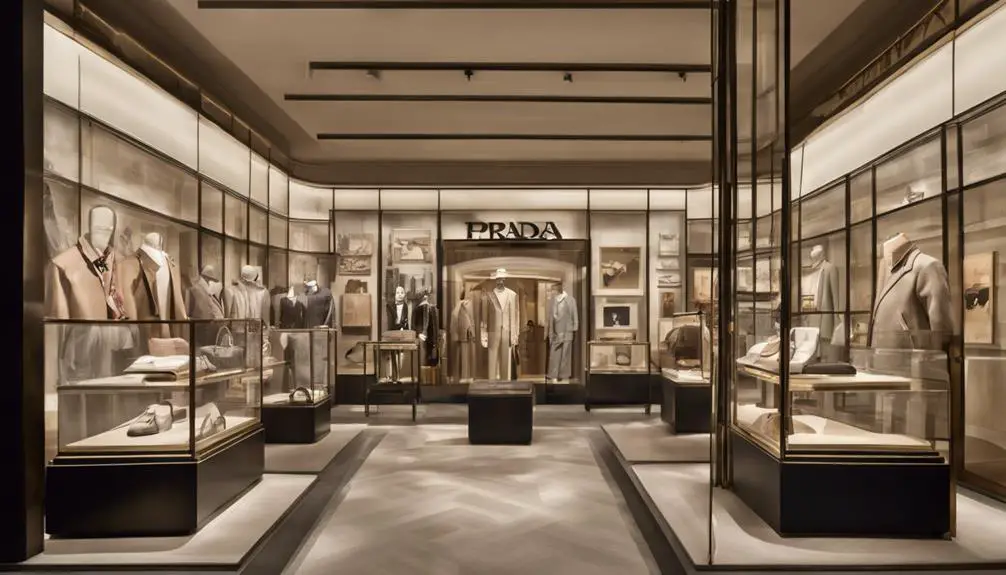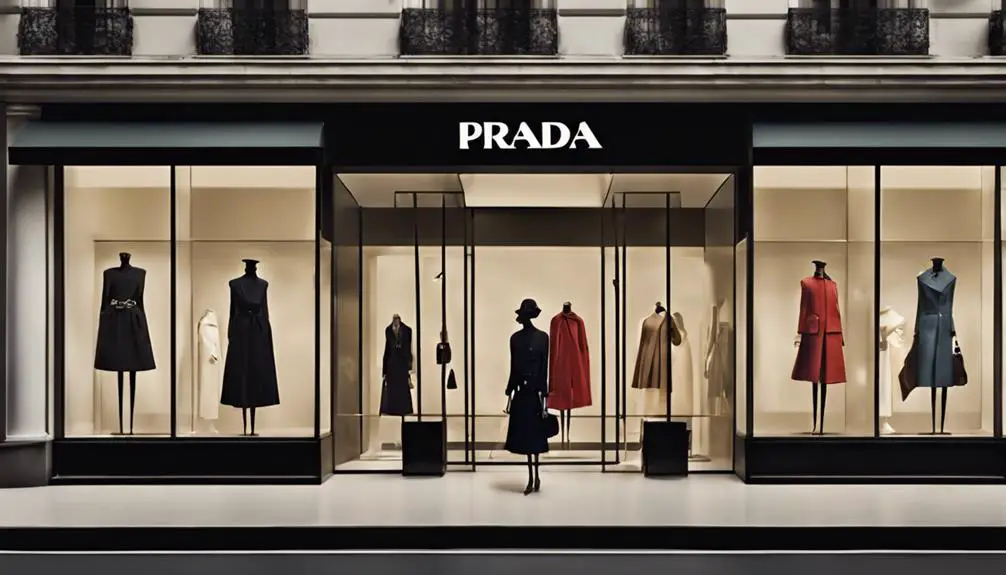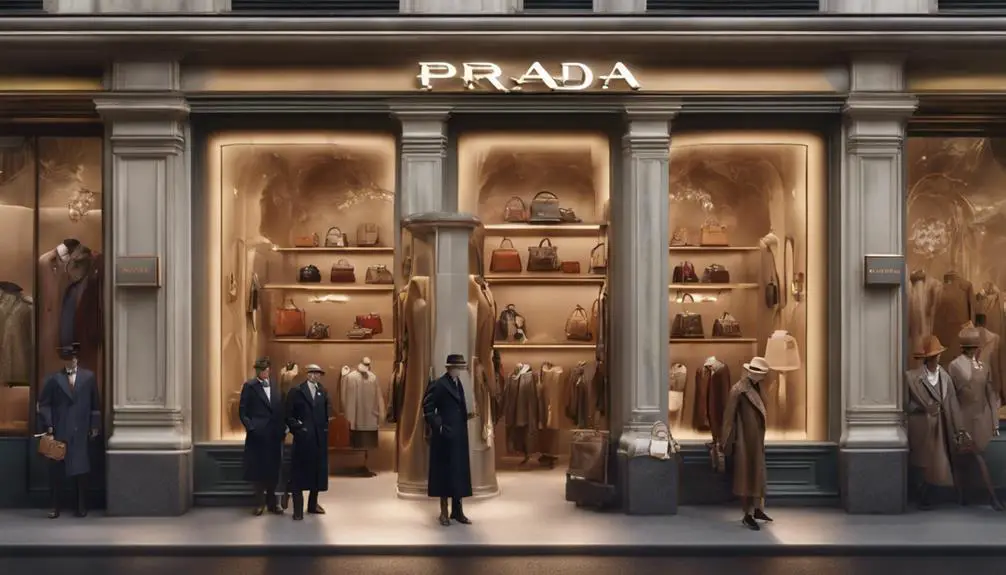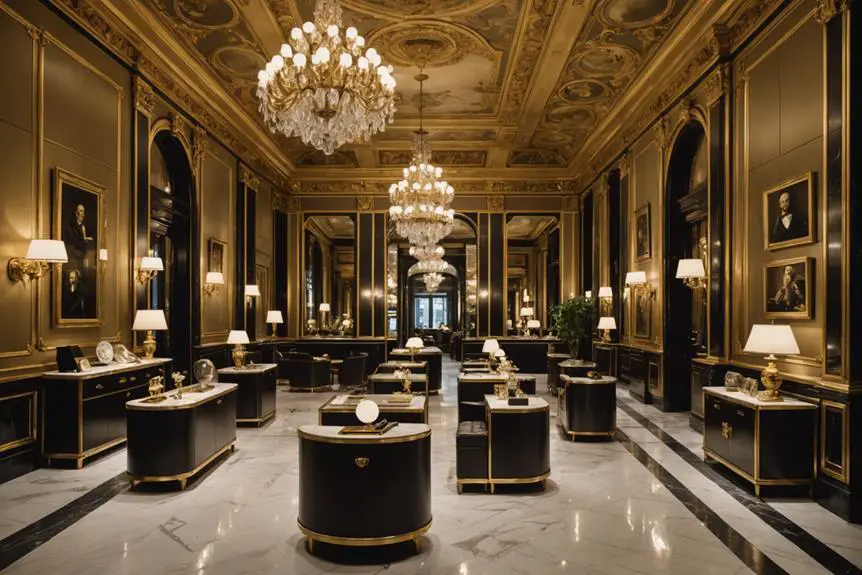Prada was born in 1913 in Milan, Italy, when Mario and Martino Prada established the company as "Fratelli Prada." They initially focused on luxury leather goods and quickly gained recognition, becoming the official supplier to the Italian Royal Household in 1919. As the brand evolved, Miuccia Prada took the reins in the 1970s, steering the company toward modern fashion trends. She launched the first women's ready-to-wear collection in 1988, reshaping Prada's identity. Over the years, the brand's unique materials and innovative designs set trends in the fashion world, creating a legacy that still influences culture today. You might find the journey of Prada even more intriguing!
Origins of Prada

Founded in 1913, Prada began as a leather goods shop called "Fratelli Prada" in Milan, Italy, operated by Mario and Martino Prada. This family business quickly gained a reputation for high-quality luxury items, especially leather goods.
Just six years later, in 1919, Prada became the official supplier to the Italian Royal Household, showcasing its commitment to refined craftsmanship and iconic logo characteristics. This prestigious recognition greatly boosted its status in the world of luxury fashion.
As time went on, the brand underwent a transformation. In the 1970s, Miuccia Prada, Mario's granddaughter, joined the family business and brought a fresh perspective. With her vision, the company shifted from traditional leather goods to embrace modern fashion trends.
Miuccia's innovative ideas helped redefine Prada's identity, making it relevant to a new generation. The launch of the first ready-to-wear collection for women in 1989 marked a pivotal moment in Prada's history.
This collection showcased Miuccia's unique approach to design, blending elegance with practicality. It solidified Prada's position as a major player in the fashion industry, known for its distinctive style and attention to detail.
Today, Prada is recognized as a global luxury fashion powerhouse, celebrated for its innovative designs and high-quality materials, including the iconic Nylon. From its humble beginnings in Milan to its status as a fashion icon, Prada's journey reflects a rich heritage of craftsmanship and creativity, setting the stage for its continued success in the luxury market.
Key Milestones in History
Prada's journey is marked by several key milestones that have shaped its identity and influence in the fashion world. Founded in 1913 in Milan by Mario and Martino Prada, the brand initially focused on luxury leather goods and travel accessories. This commitment to quality quickly earned it a reputation that would resonate through history.
In 1919, Prada became the official supplier to the Italian Royal House, solidifying its place as a premium brand synonymous with luxury.
The brand experienced a pivotal shift in the 1970s when Miuccia Prada joined the family business. Taking over in 1978, she brought a fresh vision that transformed Prada's identity. In 1988, the launch of the first women's ready-to-wear collection marked another significant milestone, showcasing Miuccia's innovative approach to fashion and expanding the brand's influence within the industry.
By the 1990s, Prada achieved global recognition, operating in 40 locations worldwide. The brand became a status symbol in luxury fashion, admired for its cutting-edge designs and sophisticated aesthetic.
Each of these milestones reflects not just the growth of a brand, but also the evolution of fashion itself. These key moments in Prada's history illustrate how the brand has consistently pushed boundaries and redefined luxury, leaving an indelible mark on the fashion world.
As you explore Prada's past, you'll see how each achievement contributes to its legacy, ensuring it remains a powerful force in contemporary fashion.
Miuccia Prada's Influence

Transforming the landscape of luxury fashion, Miuccia Prada's influence has been nothing short of revolutionary. When she joined the family business in the 1970s, she brought a fresh perspective that shifted Prada from its traditional roots to a modern luxury brand.
Taking over creative leadership in 1978, she set the stage for what would become her signature style: innovative and minimalist designs that challenged the norms of fashion.
In 1984, Miuccia introduced the iconic nylon Vela bag, turning a simple, functional fabric into a coveted luxury item. This move not only redefined the brand's identity but also established a new standard for materials in high fashion.
The launch of Prada's first runway collection in 1988 further solidified her influence, earning critical acclaim and positioning the brand as a major player in the luxury market.
Miuccia's vision didn't stop with women's fashion. In 1993, she expanded the business into menswear, showcasing her ability to shape trends across genders.
Her innovative use of unconventional materials and dedication to minimalist aesthetics became defining characteristics of the Prada brand, influencing countless designers and setting a new benchmark for luxury.
Miuccia Prada's influence continues to resonate throughout the fashion industry, inspiring new generations to explore creativity and redefine what luxury means.
Her unique approach hasn't only transformed the brand but has also left an indelible mark on the entire landscape of luxury fashion.
Expansion and Brand Development
Under Miuccia Prada's visionary leadership, the brand underwent significant expansion and development that solidified its status in the luxury fashion arena. When Miuccia joined the family business in the 1970s, she transformed the original leather goods shop, "Fratelli Prada," located in the iconic Galleria Vittorio Emanuele II. This shift marked the beginning of a new era for the Prada brand.
In 1919, just six years after its founding, the brand gained prestige as the Official Supplier to the Italian Royal Household, showcasing its commitment to luxury and quality. However, it was Miuccia's innovative designs that truly propelled the brand forward. In 1988, she launched Prada's first women's ready-to-wear collection during Milan Fashion Week, a pivotal moment that established Prada as a major player in the fashion industry.
Continuing this momentum, Miuccia expanded the brand's offerings to include a menswear collection, debuting in Spring/Summer 1998. This move further cemented Prada's reputation as a global luxury fashion powerhouse. Her creative vision and keen understanding of market trends allowed the Prada brand to evolve while staying true to its roots.
Through these strategic expansions and a focus on high-quality materials, Miuccia Prada has guaranteed that the brand not only thrives but also influences the fashion landscape.
Today, Prada stands as a representation of innovation and excellence, attracting fashion enthusiasts worldwide and continually redefining luxury.
Cultural Impact and Legacy

Throughout its history, Prada has become an iconic symbol of Italian aristocracy, shaping the landscape of luxury fashion since its inception in 1913. Recognized for its innovative designs, Prada has consistently set trends that redefine what luxury means. By introducing unique materials and styles, the brand has influenced modern fashion trends and inspired countless designers around the world.
In the 1990s, Prada's marketing strategies shifted the luxury narrative. Instead of focusing on status, the brand emphasized originality and authenticity. This anti-status approach allowed a new generation to appreciate luxury in a more personal way. You can see this shift reflected in the brand's strong presence at global fashion weeks, where its runway shows continue to captivate audiences.
Prada's commitment to contemporary art further solidifies its role as a cultural influencer. The establishment of the Prada Foundation showcases the brand's dedication to not only fashion but also the arts and culture. It illustrates that Prada's legacy extends beyond clothing; it's about shaping a cultural dialogue.
In a world where fashion can sometimes feel superficial, Prada stands out by promoting art, individuality, and authenticity. Its influence on luxury fashion and commitment to innovative designs guarantee its position as a leader in the industry.
As you explore Prada's journey, you'll discover how it has intertwined itself with the essence of luxury, leaving an indelible mark on both fashion and culture.




